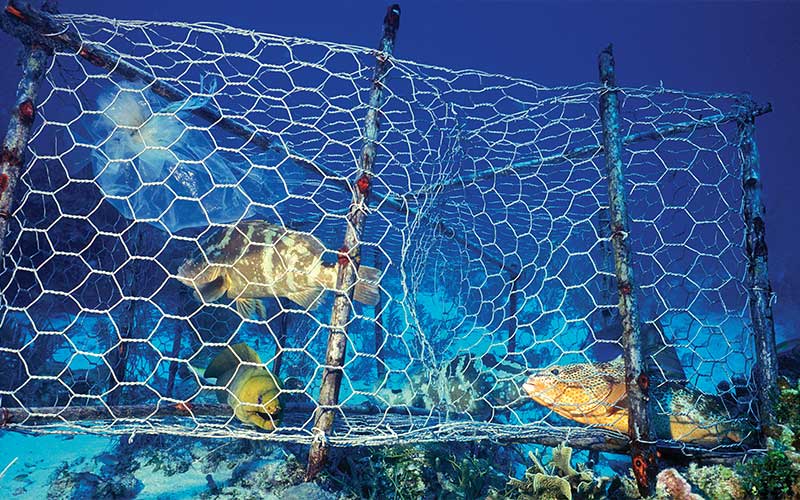In recent history there are many examples of overfishing, which have been brought about by the human exploitation of marine resources at a pace faster than the targeted species can replace itself. The story of the bluefin tuna is a good example of human greed and the lack of effective management of an international resource.
The Phoenecians, Romans and Spaniards harvested bluefin tuna in shore-based traps that caught only a portion of the population swimming into the Mediterranean from the Atlantic on their annual spawning migration. So predictable were the movements of the bluefin tuna that this method of harvest worked for more than 2,000 years, but it was not so effective that it reduced the breeding stock. It was sustainable fishing, and the Roman army marched on salted tuna for hundreds of years.
Now introduce the technology developed in World War II, bring in long-range high-seas fishing fleets using longlines and purse seines, add a growing demand for protein from fish, and you have all the ingredients for overharvesting. The tunas are now accessible everywhere they swim, and without effective international management, countries squabble over quotas and allocations, while the resource diminishes and the price goes up. In 40 years, a fishery that was sustainable for thousands of years has been essentially wiped out.
There are some species that can reproduce fast enough to accommodate this rate of extraction, such as yellowfin tuna, skipjack tuna and some salmon species. But many cannot, including all species of sharks, hence the low current levels of their populations. Most commercial fishing methods are wasteful and indiscriminate, resulting in a high by-catch of non-targeted species. Such methods include bottom trawling (for shrimp and finfish), longlining, purse seining, gill nets and drift nets. The by-catch from all these fishing methods is mostly discarded.
Another wasteful fishing technique was the purse seining of tuna under flotsam (floating objects in the open ocean). Spotted dolphins and spinner dolphins died in purse seines set on tuna in the tropical eastern Pacific, and because of public outrage, fishing practices were changed to allow the dolphins to escape over the top of the net while holding the tuna in the purse. This was a fine solution for the dolphins but not for a large variety of other species that congregate beneath flotsam, particularly juvenile tunas and other open-ocean species including sharks, jacks, chubs, dolphin fish, mantas and billfish. The result of “dolphin-safe fishing” was the annihilation of all these species as by-catch by the thousands of tons. In addition, many of the big-eye and yellowfin tuna caught under flotsam were too small to be processed for the market and were shoveled overboard. Harvesting immature individuals before they had spawned defies the basic principle of fishery management.
Coral reef fisheries have also suffered. In my native country of Jamaica, I grew up enjoying healthy coral reefs loaded with fish. In just a few decades, however, a growing population had taken its toll on this accessible food source. There is widespread use of fish traps (an unselective method of fishing) together with hand-lining and spearfishing. Even these low-tech, subsistence-level methods of extraction have annihilated fish species on reefs shallower than 100 feet. Neighboring offshore banks have also been stripped of fish, as well as conch and lobster.

Enforceable regulations do help. Many countries are reacting to overfishing and realize the socioeconomic value of having living marine species to fuel ecotourism, which includes catch-and-release sport fishing. These countries, particularly the United States, Australia and some nations in Central America, have bag limits and size limits on many popular species of game fish, closed areas, closed seasons and minimum size limits. In the Cayman Islands, where I now live, the implementation of marine parks and no-take zones and the protection of grouper spawning sites has made a big difference. In Belize, snapper and grouper spawning aggregations are at last being afforded protection after 30 years of overfishing.
For my part, I continue to fund research and shoot documentaries on sharks through the Guy Harvey Research Institute. The Guy Harvey Ocean Foundation raises funds for the GHRI and is concerned with outreach and education. To that end, we publish a list of fish species that are sustainably harvested. It may seem like a small step, but consumer demand ultimately drives the hunt for marine food species. When we make smarter choices in restaurants and markets, we create a powerful incentive for commercial fishing interests to make smarter choices, too, in terms of the species they fish and the methods they use to extract them.
It is our responsibility as consumers to be educated about these issues and do the right thing.
For More Information
Founded by marine biologist and artist Guy Harvey, the Guy Harvey Ocean Foundation is focused on developing sensible strategies for promoting the conservation of our oceans and nurturing the next generation of marine scientists and guardians of our seas. The foundation funds exceptional research and innovative educational programs that lead to sensible solutions to the many challenges facing our oceans. For more information, visit guyharveyoceanfoundation online.
© Alert Diver — Q1 Winter 2010